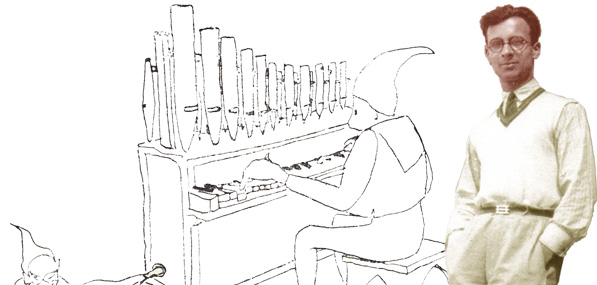
AS WE CELEBRATE the centennial in 2011 of the birth of Jehan Alain Ariste(1911–40), the opportunity to speak with one of his foremostdisciples may open windows to many who have yet to explore the wealth of his organ compositions.
Helga Schauerte, through her concert tours and CDs (the complete organ works of Jehan Alain, Johann Sebastian Bach, and Dieterich Buxtehude, portraits of Buttstett, Corrette, Reger, Boëllmann,Dubois, and Langlais, comprising some 30 recordings), as well as her musicological research, has within a few years become one of the outstanding musicians of her generation. Organist of the German Lutheran Church in Paris, teacher at the Conservatoire Nadia et Lili Boulanger, also in Paris, lecturerand jury member for international organ competitions, Schauerte maintains a brilliant career as a performing artist in Europe and throughout theUnited States.
Since 1990, her biography has been included in the International Who’s Who in Music, and she has been selected to be included in 2,000 Outstanding Musicians of the 20th Century.
Our friendship of 25 years is rooted in a mutual love for Jehan Alain’s musicand in an insatiable curiosity about the personality and philosophies of this complex musician and composer. Saint-Germain-en-Laye, a suburb eleven miles west of Paris overlooking the Seine, was both Alain’s birthplace and final resting place. The oldest of four musically gifted children, Alain grew up surrounded by music. His father, Albert, who was the titular organist of the parish church in Saint-Germain- en-Laye and a composer and organbuilder, conveyed to his children the fruits of study with the renowned musican-composers Louis Vierne, Alexandre Guilmant, and Gabriel Fauré. Jehan’s grandmother, Alice Alberty, was an excellent pianist. Jehan inherited from his grandmother not only musical genes but an attachment to literature coupled with a gift for poetic expression. Jehan’s sister Marie- Odile (1914–37) was an outstanding soprano and talented pianist; his brother Olivier (1918–95) was an acknowledged musicologist, critic, and composer; and Marie-Claire, youngest of the siblings (b. 1926), is a worldrenowned concert organist, recording artist, and teacher...
Having learned the fundamentals of piano techniques and harmony from his father, Jehan was sufficiently skilled at age eleven to begin substituting as organist at the parish church in Saint-Germain- en-Laye while his father traveled between it and several other churches in the region that he served. Proceeding from this foundation to private piano tutelage with August Pierson, titular organist of the Cathédrale Saint-Louis-de- Versaille, Jehan developed additional skills, which included an extremely supple and rapid wrist motion resulting in mastery of the rapid staccato technique that was demanded later by many of his piano and organ compositions.The piano was his instrument of choice until enrolling in 1934 in the organ class of Marcel Dupré at the Paris Conservatory, where he had begun music studies in 1927, interrupting his normal secondary-school regimen. He said of himself upon undertaking organ study that he “was neither pianist nor organist, only a bit of an acrobat and scarcely an improviser: a sort of genuine (sincere) charleton!” It is the organist Jehan Alain, however, who is known to the world outside France, for it is his organ compositions that have found their way onto recital programs from the mid-1950s and that have gained in importance as major competition and performance repertoire alongside the compositions of his contemporaries.
Alain commenced prolific composition in 1929 after enrolling in the harmony class of André Bloch at the conservatory. His subsequent study of counterpoint and fugue with Georges Caussade and of composition, first with Paul Dukas and then with Jean Roger- Ducasse, increased his store of knowledge but may not, however, have influenced his individualistic compositional style as much as those currents outside the narrow confines of the conservatory. The Paris Colonial Exhibition of 1931 affected him immensely, introducing him to the music, dance, and philosophies of the Far East. Other influences were the early jazz movement, the rebirth of interest in music of the Baroque era, and modality as expressed in Gregorian chant.
Much of his composing was accomplished under other than structured circumstances, i.e., while on the train en route from Saint-Germain-en-Laye to Paris; secretly on his lap during classes at the Paris Conservatoire; or while on vacation with his family in the Alps. Encompassing the media of organ, solo voice, choir, strings, and woodwinds, as well as piano, and essentially distinguished by a clarity of writing, richness of tonal colors, and diversity of rhythm, his body of more than 130 compositions embraces a high degree of intensely intimate expression and explosive vitality.
Peggy Kelley Reinburg
Copyright 2011, by the American Guild of Organists. Reproduced by permission of The American Organist Magazine

/image%2F2704518%2F20180320%2Fob_4e0212_header-lior2id.jpg)